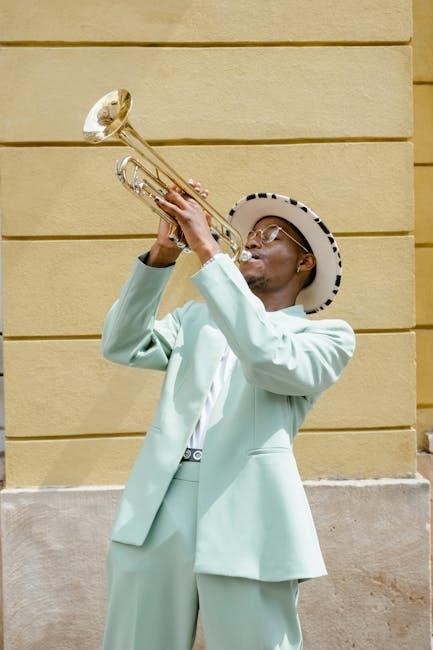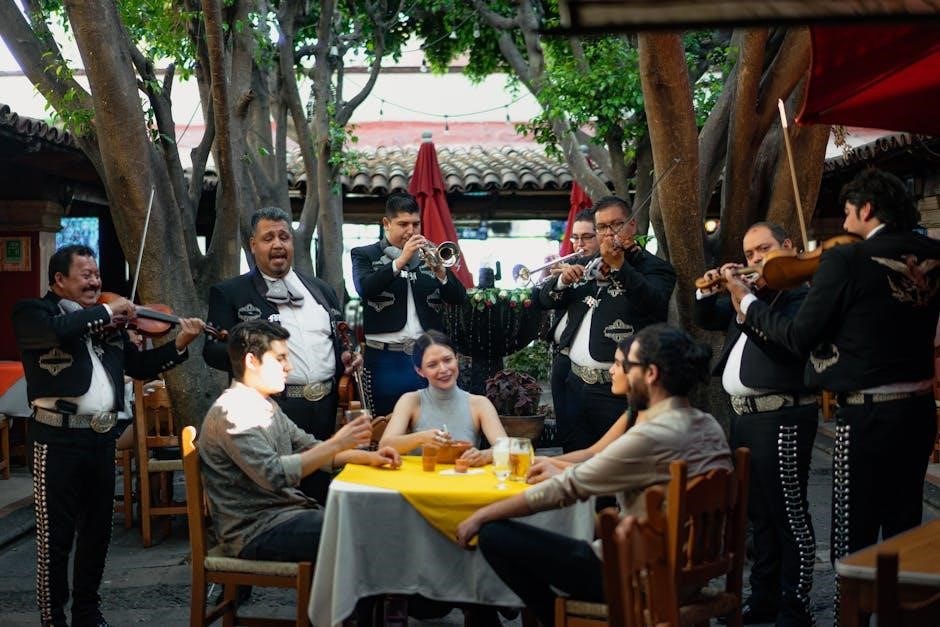Johann Nepomuk Hummel’s Trumpet Concerto in E major, composed in 1803 for Anton Weidinger, is a cornerstone of trumpet repertoire, showcasing the keyed trumpet’s capabilities.
Overview of the Concerto’s Importance
Hummel’s Trumpet Concerto in E major is a cornerstone of classical trumpet repertoire, celebrated for its virtuosic demands and lyrical beauty. Composed for Anton Weidinger, it highlights the keyed trumpet’s capabilities, blending technical brilliance with expressive melodies. Its enduring popularity stems from its balanced structure and innovative use of the instrument, making it a landmark work in trumpet literature and a favorite among performers and audiences alike.
Historical Context and Composition
Completed in December 1803, Hummel’s Trumpet Concerto was premiered on New Year’s Day 1804, marking his entry into the Esterházy court orchestra. It was tailored for Anton Weidinger, a virtuoso of the keyed trumpet, whose innovations expanded the instrument’s range and expressiveness. The concerto reflects the transition from Classical to Romantic styles, showcasing Hummel’s mastery of orchestration and melodic craftsmanship, tailored to the technical advancements of the keyed trumpet.

Johann Nepomuk Hummel and His Contribution to Trumpet Music
Hummel, a student of Mozart, elevated trumpet music with his iconic concerto, tailored for Anton Weidinger’s keyed trumpet, marking a pivotal moment in its evolution.
Biographical Sketch of the Composer
Johann Nepomuk Hummel (1778–1837) was a child prodigy, pianist, and composer who bridged the Classical and Romantic eras. A student of Mozart, he toured Europe as a virtuosic pianist before becoming Kapellmeister at the Esterházy court. Known for his piano works, Hummel’s Trumpet Concerto remains his most celebrated contribution, showcasing his mastery of orchestration and innovation in trumpet music.
Hummel’s Role in the Development of Trumpet Music
Johann Nepomuk Hummel played a pivotal role in advancing trumpet music by composing his concerto for the keyed trumpet, an instrument pioneered by Anton Weidinger. This work expanded the trumpet’s technical possibilities, showcasing its chromatic capabilities and expressive range. Hummel’s concerto elevated the trumpet from a primarily orchestral instrument to a soloistic virtuoso vehicle, influencing future compositions and cementing its place in classical repertoire;
The Trumpet Concerto in E Major, S.49
Composed in 1803, Hummel’s Trumpet Concerto in E Major is a cornerstone of trumpet repertoire, celebrated for its technical brilliance and lyrical depth, showcasing the keyed trumpet.
Structure and Movements of the Concerto
Hummel’s Trumpet Concerto in E Major, S.49, consists of three movements: Allegro con spirito, Andante, and Rondo: Allegro. The Allegro opens with a vibrant, celebratory theme, while the Andante provides a lyrical contrast. The Rondo finale, marked by its virtuosic flourishes, highlights the trumpet’s technical and expressive capabilities. The work is scored for solo trumpet, flute, oboes, clarinets, horns, timpani, and strings, showcasing the keyed trumpet’s extended range and agility.
Key Features and Musical Characteristics
Hummel’s Trumpet Concerto in E Major is renowned for its virtuosic demands and elegant phrasing, tailored for the keyed trumpet. The concerto showcases lyrical melodies, technical flourishes, and a balanced interplay between the soloist and orchestra. Its movements blend classical proportions with early Romantic expressiveness, featuring bright fanfares, soaring themes, and rhythmic vitality. The work highlights the trumpet’s agility and tonal richness, making it a cornerstone of the instrument’s repertoire.
Anton Weidinger and the Keyed Trumpet
Anton Weidinger, a virtuosic trumpeter, revolutionized the instrument by inventing the keyed trumpet, enabling chromatic playing and inspiring Hummel’s concerto, tailored to its capabilities.
The Inventor of the Keyed Trumpet
Anton Weidinger, an Austrian trumpeter, pioneered the keyed trumpet in the early 19th century. His innovative design added keys, allowing for precise chromaticism and expanded tonal possibilities. This invention addressed the natural trumpet’s limitations, making it more versatile for virtuosic performances. Weidinger’s advancements not only enhanced the trumpet’s technical capabilities but also inspired composers like Hummel to create works showcasing its new potential.
The Influence of the Keyed Trumpet on Hummel’s Composition
Hummel’s Trumpet Concerto was directly influenced by the keyed trumpet’s capabilities. The instrument’s extended range and chromatic accuracy allowed Hummel to craft complex melodies and harmonies. The concerto’s structure, including its three movements, was tailored to highlight the keyed trumpet’s virtuosic potential, ensuring a balance between technical brilliance and musical expression. This innovation enabled Hummel to push the boundaries of trumpet music, creating a masterpiece that remains central to the repertoire.

Performance and Interpretation of the Concerto
The Hummel Trumpet Concerto is a beloved staple in classical performances, requiring precision and artistry. Virtuosos like Maurice André and Alison Balsom have delivered iconic interpretations, showcasing its lyrical and technical brilliance. The concerto’s structure and orchestral accompaniment provide a rich canvas for expressive interpretation, making it a cornerstone of trumpet repertoire and a testament to the instrument’s virtuosic potential.
Challenges and Techniques Required for Trumpet Players
The Hummel Trumpet Concerto demands exceptional technical mastery, including precise articulation, breath control, and chromatic agility. Players must navigate intricate passages, wide intervals, and lyrical phrasing seamlessly. The concerto’s three movements—Allegro con spirito, Andante, and Rondo—require distinct approaches, from clarity in fast tempos to expressive nuance in slower sections. Modern trumpet players must also adapt to the historical context of the keyed trumpet, emphasizing embouchure strength and finger dexterity for the concerto’s virtuosic demands.
Notable Performances and Recordings
Famed trumpeters like Maurice André, Alison Balsom, and Tine Thing Helseth have delivered iconic performances of Hummel’s concerto. André’s 1985 recording with the RTVE Symphony Orchestra stands out for its technical brilliance. Balsom’s rendition, praised for its lyrical elegance, highlights the concerto’s melodic depth. These recordings, along with those by Tina Horvat and Kentaro Nishimura, showcase the work’s enduring appeal and varied interpretative approaches, inspiring new generations of musicians.
Significance in the Trumpet Repertoire
Hummel’s Trumpet Concerto is a cornerstone of trumpet repertoire, celebrated for its technical brilliance and lyrical elegance, remaining a favorite among performers and audiences alike.
Comparison with Other Trumpet Concertos
Hummel’s Trumpet Concerto stands as a cornerstone alongside Haydn’s concerto, sharing similar brilliance but offering distinct lyrical depth. While Haydn’s work is celebrated for its clarity and precision, Hummel’s concerto expands on technical demands and expressive range, leveraging the keyed trumpet’s capabilities. Its structure and virtuosic passages make it a favored choice, blending classical form with Romantic-era virtuosity, ensuring its enduring prominence in the trumpet repertoire.
Legacy and Popularity in Modern Times
Hummel’s Trumpet Concerto remains a beloved staple in modern trumpet repertoire, admired for its technical brilliance and melodic beauty. Its enduring appeal is evident in frequent performances and recordings by virtuosos like Alison Balsom and Maurice André. The concerto’s accessibility through PDF scores has further cemented its popularity, allowing aspiring musicians to study and perform this timeless masterpiece, ensuring its legacy endures across generations of trumpet enthusiasts and classical music lovers alike.

Accessing and Utilizing the Hummel Trumpet Concerto PDF
Access Hummel’s Trumpet Concerto PDF from IMSLP.org for free, ensuring high-quality sheet music. Utilize it to practice and study Hummel’s renowned composition effectively.
Where to Find Reliable PDF Scores
Reliable PDF scores of Hummel’s Trumpet Concerto can be found on platforms like IMSLP.org, which offers free, high-quality downloads. Musicnotes and Sheet Music Plus also provide accurate versions for purchase. Ensure the publisher is reputable for the best results. Additionally, many university libraries and online archives offer access to scanned manuscripts and modern transcriptions of the concerto.
Tips for Trumpet Players Using the PDF Version
When using the PDF version of Hummel’s Trumpet Concerto, ensure your device zooms in for clear reading. Use annotation tools to mark dynamics, articulations, and breath marks. Practice with a metronome to master tempos and phrasings. Break the concerto into sections for focused practice. Record yourself to track progress and refine intonation. Collaborate with a pianist or use backing tracks to simulate orchestral accompaniment.

The Orchestra and Instrumentation
The orchestra for Hummel’s Trumpet Concerto includes flute, oboes, clarinets, horns, timpani, and strings, providing a rich accompaniment to the solo trumpet.
Orchestral Accompaniment and Instrumentation
The orchestral accompaniment for Hummel’s Trumpet Concerto features a classical ensemble, including flute, two oboes, two clarinets, two horns, timpani, and strings. Composed in 1803 for Anton Weidinger, the instrumentation supports the solo trumpet with a balanced and vibrant texture, typical of early 19th-century concertos. This setup ensures a dynamic interplay between the soloist and the orchestra.
Historical and Modern Instrumentation Practices
Historically, Hummel’s concerto was written for Anton Weidinger’s keyed trumpet, enabling chromatic passages. Today, modern valved trumpets replicate the keyed trumpet’s capabilities, offering brighter tones and improved agility. The orchestration remains faithful to the original, with slight adaptations to suit contemporary instruments, ensuring the concerto’s timeless appeal and technical demands remain intact for modern performers.

Learning and Mastering the Concerto
Mastering Hummel’s Trumpet Concerto requires precise technical skill and musicality. Aspiring players benefit from detailed lessons and resources, such as those by Rolf Smedvig, to refine their interpretation and technique.
Educational Resources and Guides
Educational resources for mastering Hummel’s Trumpet Concerto include detailed lessons by renowned trumpeter Rolf Smedvig, offering insights into technique and interpretation. Sheet music and guides are available on platforms like 8notes.com, providing access to the concerto’s third movement for practice. Additionally, the IMSLP website offers a comprehensive score, enabling in-depth study. These resources, combined with dedicated practice, help aspiring musicians refine their skills and deliver a polished performance.
Practice Techniques for Aspiring Trumpet Players
Mastering Hummel’s Trumpet Concerto requires focused practice. Begin with slow tempos to refine articulation and intonation, gradually increasing speed. Emphasize breath control and phrasing, especially in the lyrical Andante movement. Break the concerto into sections, practicing challenging passages repeatedly. Utilize metronomes for precision and explore recordings by virtuosos like Maurice André for inspiration. Regularly review sheet music, such as the PDF version, to ensure accuracy and musicality in your performance.
Hummel’s Trumpet Concerto remains a timeless masterpiece, blending technical brilliance with lyrical beauty. Its enduring popularity underscores its significance in the trumpet repertoire, offering a bridge between classical and romantic styles.
Hummel’s Trumpet Concerto in E major, composed in 1803, remains a cornerstone of trumpet repertoire due to its virtuosic demands and lyrical beauty. Its innovative use of the keyed trumpet, balanced with classical structure, appeals to both performers and audiences. The concerto’s technical brilliance and expressive melodies continue to inspire trumpet players, solidifying its place as a timeless masterpiece in classical music.
Encouragement for Further Exploration and Study
Trumpet players and music enthusiasts are encouraged to explore Hummel’s concerto through accessible PDF scores and recordings. Studying the work offers insights into classical trumpet technique and historical performance practices. Aspiring musicians can benefit from masterclasses and tutorials, while audiences can appreciate the concerto’s enduring elegance and virtuosic charm, making it a rewarding piece for both study and enjoyment.
Additional Resources and References
Discover comprehensive resources like IMSLP for Hummel’s Trumpet Concerto scores, notable performances by Maurice André, and educational masterclasses to enhance your understanding and appreciation of the piece.
Recommended Sheet Music and Scores
For high-quality sheet music, visit IMSLP.org, which offers Hummel’s Trumpet Concerto in E major, S.49, as a free PDF. The Werner Icking Music Collection provides detailed scores, including orchestral parts. Musicnotes and Sheet Music Plus also offer digital versions, ensuring clarity and accuracy. Additionally, 8notes.com features the concerto’s third movement for free, ideal for educational purposes. These resources are essential for trumpet players seeking reliable materials for practice and performance.
Suggested Recordings and Performances
Notable recordings include Alison Balsom’s rendition with the Deutsche Kammerphilharmonie, offering a vibrant interpretation. Maurice André’s 1985 performance with the RTVE Symphony Orchestra is a classic. Tine Thing Helseth delivers a modern, nuanced take. These recordings are available on platforms like Spotify and YouTube, providing inspiration and insight into the concerto’s nuances. They are invaluable resources for trumpet players aiming to master Hummel’s iconic work.



